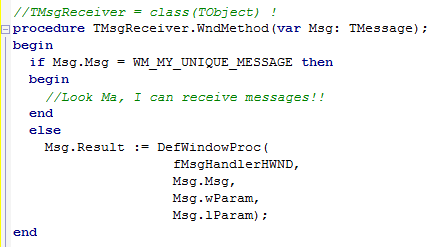 Windows messages are a key ingredient in communication between Windows and (your) application and also in communication between (two) applications.
Windows messages are a key ingredient in communication between Windows and (your) application and also in communication between (two) applications.
Even without your knowledge Windows messages are being posted and handled by forms in your application.
For example, when the user closes the form in your application, the WM_CLOSE message is sent to the window/form and the form gets closed (if you do not react programmatically).
For an application to receive a Window message, the application must provide a *window* a message will be sent to. In normal situation this window is the (main) form in your application. You write a procedure to handle a specific message, like WM_NCHitTest, and you are done.
BUT, what if you do NOT have a window to receive a message? What if you want to handle messages in your custom class derived from TObject?
Handle Windows Messages in TMyObject = class(TObject)
A Delphi control that has a window handle (derives from TWinControl) can receive Windows messages. The TObject does not expose a window handle, and therefore any of your custom classes (deriving from TObject) cannot receive and handle Windows messages, at least not “by default”.
To enable your custom class to receive Windows messages you must provide a window handle to the message sender.
The trick is in using the following methods (defined in classes.pas – therefore straightforward to use):
- AllocateHWnd(WndMethod : TWndMethod). AllocateHWnd is used to create a window that is not associated with a windowed control.
- The WndMethod : TWndMethod specifies the window procedure that the generated window uses to respond to messages.
- DeallocateHWnd. DeallocateHWnd destroys window that was created using the AllocateHWnd function.
The TMsgReceiver skeleton below is a custom class derived from TObject capable of receiving and handling Windows messages.
interface
TMsgReceiver = class(TObject)
private
fMsgHandlerHWND : HWND;
procedure WndMethod(var Msg: TMessage);
public
constructor Create;
destructor Destroy; override;
end;
implementation
constructor TMsgReceiver.Create;
begin
inherited Create;
fMsgHandlerHWND := AllocateHWnd(WndMethod);
end;
destructor TMsgReceiver.Destroy;
begin
DeallocateHWnd(fMsgHandlerHWND);
inherited;
end;
procedure TMsgReceiver.WndMethod(var Msg: TMessage);
begin
if Msg.Msg = WM_MY_UNIQUE_MESSAGE then
begin
//do something
end
else
Msg.Result := DefWindowProc(fMsgHandlerHWND, Msg.Msg, Msg.wParam, Msg.lParam);
end
In the WndMethod procedure (the window procedure for the hidden window) you handle all the messages you are interested in. For all other messages a call to DefWindowProc is needed to ensure default processing for any messages that your code does not process.
Handle a Message From Another Application
With the above skeleton, you can now handle messages sent from other applications.
Suppose some application registers Windows message using RegisterWindowMessage API call. The RegisterWindowMessage function is typically used to register messages for communicating between two cooperating applications.
The “sending” application would have a line like:
WM_MY_APP_MESSAGE := RegisterWindowMessage('MSG_MY_APP_MESSAGE');
Where WM_MY_APP_MESSAGE is a cardinal value field used when posting the message to (all) windows.
The WM_MY_UNIQUE_MESSAGE also needs to be registered in TMsgReceiver using the same “’MSG_MY_APP_MESSAGE’” – as if two different applications register the same message string, the applications return the same message value.
Let’s say we post this message in a form’s OnMouseDown event:
procedure TClickSendForm.FormMouseDown(Sender: TObject; Button: TMouseButton; Shift: TShiftState; X, Y: Integer); begin PostMessage(HWND_BROADCAST, WM_MY_APP_MESSAGE, x, y); end;
The HWND_BROADCAST parameter ensures that our WM_MY_APP_MESSAGE is posted to all top-level windows in the system, including disabled or
invisible unowned windows, overlapped windows, and pop-up windows AND our TMsgReceiver hidden window.
To handle the message in the TMsgReceiver instance have the WndMethod as:
procedure TMsgReceiver.WndMethod(var Msg: TMessage);
begin
if Msg.Msg = WM_MY_UNIQUE_MESSAGE then
begin
Point.X := Msg.LParam;
Point.Y := Msg.WParam;
// just to have some "output"
Windows.Beep(Point.X, Point.Y);
end
else
Msg.Result := DefWindowProc(fMsgHandlerHWND, Msg.Msg, Msg.wParam, Msg.lParam);
end;
The “Point” is a field in the TMsgReceiver. And there you have it – TMsgReceiver receiving where the user has clicked on the form in some other application.
And that’s it.

Nice. I going to try to implement it. Best regards
A gem of information, thanks for the contribution. Best regards.